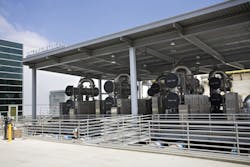The Big Question
Ultraviolet Treatment (UV) technology is recognised and used in developed water infrastructures, yet this is not always the case in developing nations, with utilities favouring traditional chemical disinfection. In light of this and part of the latest technology comparison article, WWi asks technology providers: What motivations/incentives are needed to help persuade utilities to change from chemical disinfection to UV?
Managing Misconceptions
Mike Newberry, product manager, UV, Xylem, Inc
Transition to UV disinfection from chlorine has been slow, perhaps due to misconceptions that persist from the early days of the technology. Many still believe that UV is expensive compared to chlorine, that the correct dose is difficult to determine, that it is quite energy intensive and that it requires a lot of operator time to maintain. These beliefs are no longer justified. Thanks to advances in UV technologies, as well as standardised validation protocols, none of these opinions are true today.
UV is now extremely cost competitive and in most cases has a lower life cycle cost than chlorine disinfection. The current UV lamps last much longer than those manufactured just a few years ago. They are highly energy efficient and can be controlled to deliver dosages that match the system's flow and water quality.
UV has a smaller footprint and may be retrofitted into existing chlorine contact chambers, reducing construction costs. Self-cleaning options and intensity monitors reduce operator attention and handling of the lamps, lowering labour requirements while improving performance.
UV dose determination should also no longer be a deterrent. Validation protocols for both water and wastewater set standards and methods for determining the appropriate dose for the target pathogens and water quality. Validation takes the guesswork out of dosage and allows for a more precise design, eliminating wasted capital on overdesigned systems, while assuring both utilities and regulators of effective disinfection.
Safety is one of the main advantages of UV over chlorine. By reducing or eliminating the transport and storage required for chlorine, utilities make their facilities and their communities safer.
UV is also healthier for both the customers and the environment. For drinking water processes, using UV for primary disinfection eliminates disinfection by-product (DBP) formation and reduces the amount of chlorine required for residual maintenance by up to 90% of the amount required when chlorine is the only disinfecting agent. By eliminating chemical residuals in wastewater disinfection, UV protects receiving waters and makes reuse possible.
Industry organisations, manufacturers, governments and regulatory agencies should work together to encourage the switch to UV by encouraging validation of systems, holding workshops, educating the utilities on these advantages.
Once utilities become aware of the many advantages, UV will be recognised as the preferred disinfection process.
Advanced Oxidation
Volker Adam, UV expert for water treatment, Heraeus Noblelight
The history of UV cleaning goes back 100 years. The first patented cleaning using UV light took place in the year 1910 with the aid of quartz glass lamps – a development which traces its history back to the Heraeus chief developer Richard Küch (1860 – 1915) in the year 1904. Much has changed over these 100 years.
The challenges for UV lamps today consist of significantly increasing the efficiency and working life of the lamps. A long service life and higher UV output are today a great advantage for the system designer, since he now requires fewer lamps in the design of disinfection systems. This means a substantial savings potential in terms of numbers of lamps, system components, power consumption and service costs.
Water treatment involving water disinfection using energy-intensive ultraviolet radiation is already a well established and environmentally friendly technology. The treatment of water, like drinking- , industrial process- or ballast water with UV radiation is a very effective physical process for reliably disinfecting water.
The high-energy light of a wavelength of 254 nanometers destroys the genetic make-up and, in seconds, inactivates the cells of the pathogens present in the water. Ultraviolet light is particularly effective on parasites which are chlorine-resistant. As the purification takes place without chemicals and there are no chemical residuals the quality of the water is not impaired in terms of taste or smell.
However, increasingly residuals of medications, hormones, pesticides and herbicides are affecting clean water and present new challenges for the water treatment industry. It is necessary to destroy and render harmful complex pharmaceutical molecules such as steroids and antibiotics, as well as pollutants. Furthermore, at around 0.01 euro/m³ UV light is the most cost-effective, non-chemical water disinfection technique.
With the "Advanced Oxidation" process ultraviolet radiation can break down pollutants in the water. As distinguished from water disinfection, additionally in Advanced Oxidation UV radiation below 250 nanometers is used.
The properties of even higher energy UV light are used in water purification to destroy substances in the water which are biologically difficult or impossible to break down. Chemical compounds are decomposed or more precisely converted and thus destroyed and made ineffective. The Advanced Oxidation process is carried out with UV radiation and a combination of ozone or alternatively hydrogen peroxide or both.
CAPEX and OPEX Advantages
Tony Leigh, technical sales director, atg UV Technology
As a highly effective and proven treatment technology, UV systems have become the disinfection solution of choice for many wastewater treatment plants.
UV disinfection offers a number of performance benefits and advantages for wastewater applications that are unmatched by traditional chemical methods.
UV is a highly flexible treatment technology and can be used to treat a large range of wastewater applications from low-quality primary effluent, secondary effluent and high-quality tertiary effluent, to specialist applications such as storm water treatment and pesticide removal using advanced oxidation techniques. Additionally, UV disinfection systems are not affected by the temperature or pH of the wastewater. Manufacturers of closed vessel UV systems, using the NWRI California Title 22 validation standard, can now offer operators guaranteed, 3rd party tested, disinfection performance for wastewater applications.
Typically a single pass through a correctly sized UV system will provide a 3 log (99.9%) reduction of E-Coli and Faecal Coliforms. In addition to disinfection for discharge, the NWRI validation now allows for wastewater reuse for both irrigation purposes, and more significantly drinking water projects known as 'Toilet-to-Tap'.
These projects treat final tertiary effluent using very high UV doses, and deliver treated wastewater from the outlet of the wastewater treatment works, directly to the head of the drinking water works with no environmental buffer.
Recent developments to UV system designs such as large scale multi-lamp 'closed vessel' UV chambers can significantly reduce CAPEX both for equipment and installation costs.
Additionally, advancements in lamp technology such as 800 Watt amalgam UV lamp and variable power supplies now offer up to 70% turndown on power usage offers OPEX savings.
UV vs. Chemical Disinfection: A Lifecycle Cost Evaluation
Wayne Lem, municipal market manager, Trojan Technologies
The benefits of ultraviolet (UV) disinfection are so clear that really, no additional motivations or incentives are needed. For the past two decades, and increasingly today, ultraviolet radiation (UV) has been successfully used around the world for municipal applications including wastewater and drinking water disinfection. UV is a cost-effective and reliable technology that protects the public against pathogenic microorganisms including protozoa, bacteria and viruses.
As a growing alternative and in many cases, a direct replacement technology to chemical (chlorine) disinfection, UV does not produce harmful by-products and is non-toxic to the environment. Furthermore, UV technology is recognized as the "green" disinfection solution with a low environmental impact.
As municipalities in developing countries face the challenge of treating water for the public in the most cost-effective manner, UV disinfection should be a prime consideration in the technology portfolio. UV technology has matured and is widely accepted as an alternative to or replacement for chemical disinfection in municipalities in the western hemisphere. While individual applications (e.g. wastewater, stormwater, drinking water) and treatment objectives differ, they have one important goal in common – to cost-effectively treat water for the public while minimizing the environmental impact of the treatment process.
Traditionally, disinfection using chlorine gas was the most common method of wastewater disinfection. Chlorine gas itself is relatively inexpensive but is a highly toxic chemical that must be transported and handled with extreme caution. It is stored under pressure in large tanks and is released into the wastewater as a gas. Sodium hypochlorite is a diluted liquid form of chlorine that is commonly used.
Lifecycle cost evaluation offers a good economic model to evaluate alternatives for equipment and projects. The cost of chlorination equipment is typically a small part of the overall capital cost. Because chlorination requires a lengthy retention time, a large chlorine contact tank or channel is required unless one already exists. Sodium hypochlorite (liquid chlorine) has similar equipment and chlorine contact tank costs as chlorine gas. However, if the hypochlorite is delivered to the plant, there will be additional costs associated with building storage facilities to store this corrosive chemical.
If UV equipment is to be retrofitted into an existing chlorine contact tank, the majority of the cost will come from the equipment and additional space can be reclaimed because UV's small footprint. If a concrete channel is to be constructed, the cost to accomplish this is significantly smaller compared to chlorine since the footprint of a UV system is much smaller. UV disinfection occurs in seconds whereas chlorination requires several minutes of retention time.
The annual cost of operating and maintaining a disinfection system can have a significant impact on the economic evaluation of each option. The O&M costs include the cost of chemicals, electricity, replacement parts and labour required to maintain each system. The hazards of chlorine gas results in a significant amount of investment into training staff, emergency preparedness planning and maintaining the chlorine system. Chlorine gas prices are relatively low, but this is often outweighed by the intensive maintenance and safety precautions needed for the system
Therefore, these ongoing maintenance costs associated with chlorination systems must be addressed when comparing disinfection alternatives.
O&M costs associated with UV consists primarily of lamp replacement costs and the electrical cost of operating the UV system. Any disinfection alternative evaluation should also take into account the non-economic factors that can heavily weigh into the decision-making process. These factors typically include, but are not limited to operator and community safety, ease of operation, process reliability, constructability and space requirements and sustainability/environmental impact.





